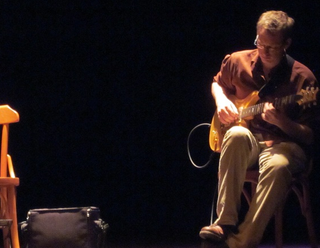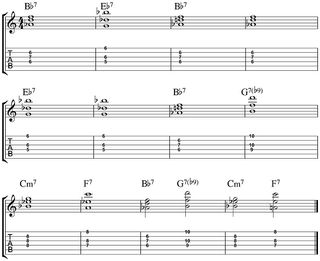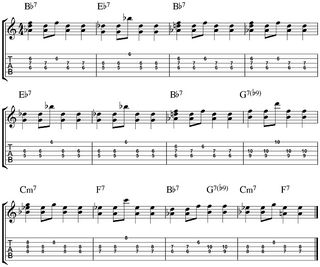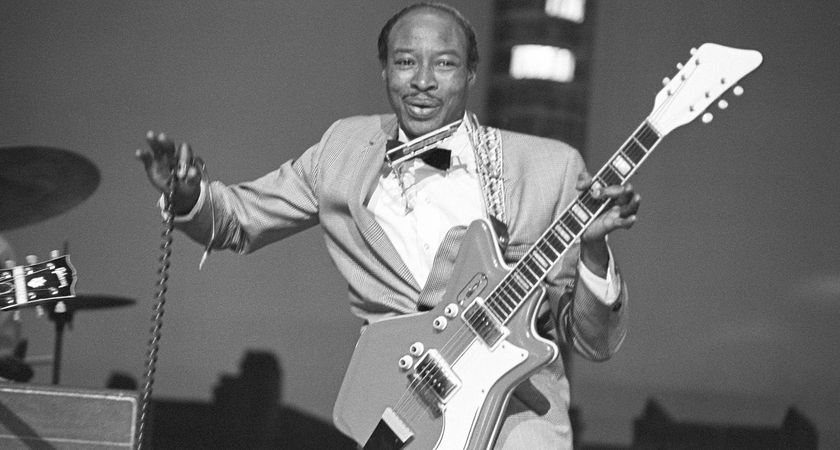Jazz Guitar Corner: Using Two-Note Chords to Play the Blues, Part 4

Continuing our study of two-note chords, built with the 3rd and 7th of each chord in the underlying progression, in this lesson we’ll be looking at adding the 5th of each chord on top of these fun and cool-sounding blues chords.
Though you are adding only one note to each chord in the progression, the 5th, you might be surprised how well this works in expanding the texture and color of the two-note chords you learned in the first two lessons of this series.
To check out the first three lessons in this series, please visit the links below.
• Using 2 Note Chords to Play the Blues Part 1
• Using 2 Note Chords to Play the Blues Part 2
• Using 2 Note Chords to Play the Blues Part 3
Fifth on Top Example 1
To get started, let’s take a look at the 3rd and 7th chords to a Bb blues progression on the fourth and fifth strings. To spice things up a bit, beyond those two notes, we’ll be adding in the 5th of each chord on top of the two-note 3rds and 7ths.
Because there are string skips involved with these shapes, strumming these chords is not really an option, so you will have to fingerpick these shapes or use hybrid picking where you mix your fingers and pick together to play each shape.
In the example below, I’ve written each chord as a basic rhythm, whole or half note, but once you get these shapes under your fingers, be sure to experiment with other rhythmic possibilities as you explore these fun and cool sounding chords in the woodshed.

The last thing to check out with these shapes is the triads they form when you play the 3rd, 5th and 7th of any chord. For 7th and 7b9 chords, which are most of the shapes in this progression, you form a diminished triad from the 3rd of each of those chords.
For example, the 3rd, 5th and 7th of Bb7 are D F Ab, which forms a D diminished triad. Knowing this can help you bring other 3,5,7 shapes to your playing, using two-note 3rds and 7ths down low or any other diminished triad shape you know or are working on in the practice room.
For the Cm7 chord, you are playing an Eb triad, Eb G Bb, and again you can use this knowledge to expand upon these three-note chords further in the practice room.
Fifth on Top Example 2
To help you move these shapes around the fretboard a bit, here's an example of the same approach, 5th on top, as applied to 3rds and 7ths for chord in a Bb blues progression, though this time with the lowest notes on the fourth and third strings.

Once you have these shapes under your fingers, try playing the chords to a Bb blues and mix both shapes together, 3rds and 7ths on the 4-5 strings as well as on the 3-4 strings. With just these two options under your fingers, you’d be surprised how many variations you can bring to your chord work when focusing on 3rd and 7th shapes in your comping.
Fifth on Top Rhythmic Exercise
To finish up our study of adding the 5th to 3rd and 7th shapes, here is a rhythmic exercise that you can work out in order to get your right hand in shape at the same time as learning these chords.
Using a Charleston rhythm, where the notes are placed on the 1 and "and" of 2 in each bar, I’ve written out a sample comping etude with the 5th being placed on top in just those specific places of each bar.
From there, the 3rds and 7ths are played as steady quarter notes, adding a Freddie Green-style rhythm to the two-note shapes, with the 5th added on top as a Charleston rhythm.

Once you have this example under your fingers, move the 3rds and 7ths around to other string sets as you expand on this rhythmic exercise further in the woodshed.
Do you have any questions about adding the fifth on top of two-note, 3rd and 7th chords? Share your thoughts in the comments section below.
Matt Warnock is the owner of mattwarnockguitar.com, a free website that provides hundreds of lessons and resources designed to help guitarists of all experience levels meet their practice and performance goals. Matt lives in the UK, where he is a lecturer in Popular Music Performance at the University of Chester and an examiner for the London College of Music (Registry of Guitar Tutors).
Get The Pick Newsletter
All the latest guitar news, interviews, lessons, reviews, deals and more, direct to your inbox!
Matt Warnock is the owner of mattwarnockguitar.com, a free website that provides hundreds of lessons and resources designed to help guitarists of all experience levels meet their practice and performance goals. Matt lives in the UK, where he teaches Skype guitar students all over the world, and is an examiner for the London College of Music (Registry of Guitar Tutors).





![Joe Bonamassa [left] wears a deep blue suit and polka-dotted shirt and plays his green refin Strat; the late Irish blues legend Rory Gallagher [right] screams and inflicts some punishment on his heavily worn number one Stratocaster.](https://cdn.mos.cms.futurecdn.net/cw28h7UBcTVfTLs7p7eiLe-840-80.jpg)







